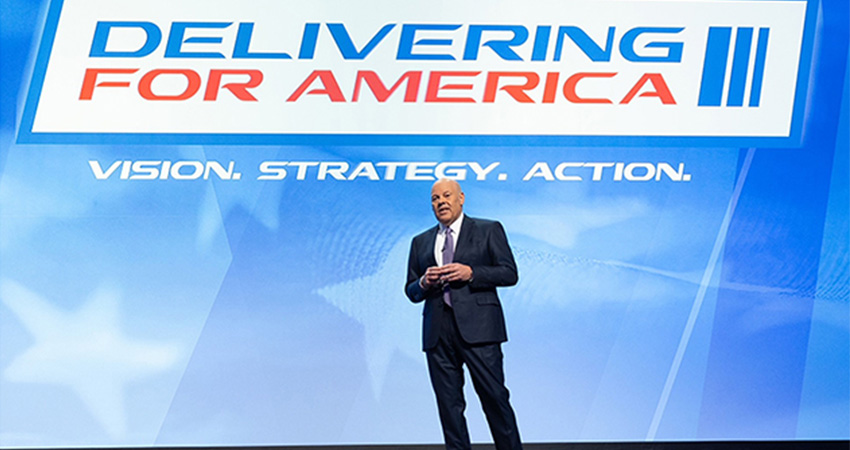Postmaster General Louis DeJoy detailed how his team is working to implement an extreme makeover of the U.S. Post Service’s distribution and delivery network, in an effort to “unwind” past mistakes that created inefficiencies and hobbled its ability to execute on its mission.
In a keynote address to the National Postal Forum in Charlotte, NC earlier this week, DeJoy said deployment of plant, labor and transportation assets was done in a haphazard fashion for years, necessitating an operating model of workarounds.
“These facilities were assembled without a national strategic operating plan or design, driving up cost, ignoring precision and reducing our ability to effectively operate,” DeJoy said. “Our package processing facilities lacked basic material handling equipment despite the increasing package volumes, requiring tens of millions of packages to be processed by hand every day.”
He said “sloppy” transportation processes created more than 50,000 truck trips a day that were 70% empty, while contracted air transportation costs soared. Several hundred network facilities, DeJoy said, had “random and illogical layouts,” hindering performance and leading to billions in deferred maintenance.
After he took over in June 2020, DeJoy said, teams deployed throughout the organization documented mail and parcel flow to assess the current state, which fed into a plan to develop structural design changes.
The new network structure will include 60 regional processing and distribution centers, including 45 existing facilities and the addition of 15 more in areas experiencing high volume. Some postal annexes and outsourced functions will be folded into the regional centers. Feeding into them will be 220 local processing centers within each territory.
Both the regional and local centers will be redesigned based on updated operating requirements for mail and package processing, serving as transfer hubs to delivery centers. As a result, DeJoy said, 200 “wasteful” locations will be eliminated. “This is not a consolidation,” he insisted. “It is an aggregation of randomly deployed functionality spread out across a local area because of ill-planned deployments.”
New package sorting equipment will add capacity, DeJoy said, increasing throughput, reducing costs and improving the flow of mail and packages. “We are reconfiguring our facility equipment, our operating processes and improving our national transportation functions to logically sequence mail and package flow,” he said.
On the distribution side, DeJoy said 400 new sorting and delivery centers will be deployed over the next three years. Three hundred of them will be reconditioned mail processing plants that have been idled, enabling package processing, mail transfer, EV charging and delivery. Another 100 will be co-located in local processing centers.
“Because the (sorting and delivery centers) will be larger and centrally located facilities with more space, better parking lots, substantial electric power and other infrastructure, they will enable us to combine the delivery operations of small delivery units in the surrounding area into them,” he said.
Also, the sortation and delivery centers will feed local delivery units and retail centers, DeJoy said, “providing single access points for entering mail and packages into our last-mile delivery network that can reach many more homes and businesses from one entry point. This is a game changer!”
This new functionality will be deployed at 600 delivery units, DeJoy said. “No longer do we plan to have several thousand trucks a day roaming the nation’s streets only 30% full,” he said.

